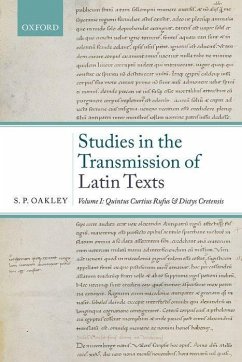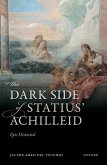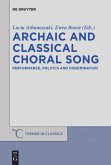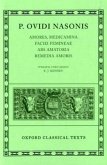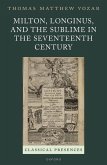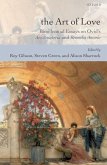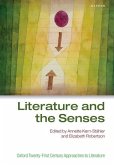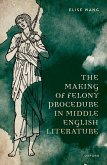S P Oakley
Studies in the Transmission of Latin Texts
Volume I: Quintus Curtius Rufus and Dictys Cretensis
S P Oakley
Studies in the Transmission of Latin Texts
Volume I: Quintus Curtius Rufus and Dictys Cretensis
- Gebundenes Buch
- Merkliste
- Auf die Merkliste
- Bewerten Bewerten
- Teilen
- Produkt teilen
- Produkterinnerung
- Produkterinnerung
This volume contains the first attempt to show in detail how two Latin texts, the history of Alexander the Great, written by Quintus Curtius Rufus, and the spoof history of the Trojan War, allegedly written by Dictys Cretensis, survived from antiquity until the fifteenth century, when printing provided a new security.
Andere Kunden interessierten sich auch für
![The Dark Side of Statius' Achilleid The Dark Side of Statius' Achilleid]() Julene Abad Del VecchioThe Dark Side of Statius' Achilleid132,99 €
Julene Abad Del VecchioThe Dark Side of Statius' Achilleid132,99 €![Archaic and Classical Choral Song Archaic and Classical Choral Song]() Archaic and Classical Choral Song22,99 €
Archaic and Classical Choral Song22,99 €![Amores, Medicamina Faciei Femineae, Ars Amatoria, Remedia Amoris Amores, Medicamina Faciei Femineae, Ars Amatoria, Remedia Amoris]() OvidAmores, Medicamina Faciei Femineae, Ars Amatoria, Remedia Amoris22,99 €
OvidAmores, Medicamina Faciei Femineae, Ars Amatoria, Remedia Amoris22,99 €![Milton, Longinus, and the Sublime in the Seventeenth Century Milton, Longinus, and the Sublime in the Seventeenth Century]() Thomas Matthew VozarMilton, Longinus, and the Sublime in the Seventeenth Century115,99 €
Thomas Matthew VozarMilton, Longinus, and the Sublime in the Seventeenth Century115,99 €![The Art of Love The Art of Love]() GibsonThe Art of Love189,99 €
GibsonThe Art of Love189,99 €![Literature and the Senses Literature and the Senses]() Literature and the Senses178,99 €
Literature and the Senses178,99 €![The Making of Felony Procedure in Middle English Literature The Making of Felony Procedure in Middle English Literature]() Elise WangThe Making of Felony Procedure in Middle English Literature103,99 €
Elise WangThe Making of Felony Procedure in Middle English Literature103,99 €-
-
-
This volume contains the first attempt to show in detail how two Latin texts, the history of Alexander the Great, written by Quintus Curtius Rufus, and the spoof history of the Trojan War, allegedly written by Dictys Cretensis, survived from antiquity until the fifteenth century, when printing provided a new security.
Hinweis: Dieser Artikel kann nur an eine deutsche Lieferadresse ausgeliefert werden.
Hinweis: Dieser Artikel kann nur an eine deutsche Lieferadresse ausgeliefert werden.
Produktdetails
- Produktdetails
- Verlag: Oxford University Press
- Seitenzahl: 534
- Erscheinungstermin: 23. September 2020
- Englisch
- Abmessung: 234mm x 163mm x 36mm
- Gewicht: 975g
- ISBN-13: 9780198848721
- ISBN-10: 0198848722
- Artikelnr.: 59324893
- Herstellerkennzeichnung
- Libri GmbH
- Europaallee 1
- 36244 Bad Hersfeld
- gpsr@libri.de
- Verlag: Oxford University Press
- Seitenzahl: 534
- Erscheinungstermin: 23. September 2020
- Englisch
- Abmessung: 234mm x 163mm x 36mm
- Gewicht: 975g
- ISBN-13: 9780198848721
- ISBN-10: 0198848722
- Artikelnr.: 59324893
- Herstellerkennzeichnung
- Libri GmbH
- Europaallee 1
- 36244 Bad Hersfeld
- gpsr@libri.de
Stephen Oakley, FBA, was born in Dorset and educated at Queens' College, Cambridge, where he studied for the Classical Tripos and for his Ph.D. He has since taught at Emmanuel College, Cambridge and the University of Reading, and is currently Kennedy Professor of Latin in the University of Cambridge and Fellow of Emmanuel College.
* Alphabetical Check-List of Sigla * 1: Introduction: Method of Investigation * QUINTUS CURTIUS RUFUS * 2: The Extant Manuscripts and Incunables * 2.1. General * 2.2. Manuscripts that do not consist of excerpts * 2.3. Manuscripts containing excerpts * 2.4. Lost or unidentified manuscripts * 2.5. Incunabular editions * 2.6. Sigla * 2.7. Portions collated * 3: The Progress of Scholarship * 4: Curtius in Northern Europe in the Middle Ages: The Primary Witnesses * 4.1. General * 4.2.
* 4.3.
* 4.4.
* 4.5. D * 4.6. S * 4.7. The Florilegium Angelicum * 5: Curtius in Northern Europe in the Middle Ages: The Family of B * 6: The Italian Tradition: Br's Family * 6.1. General * 6.2. Br and A * 6.3. A, Petrarch, and Br s family: the problem * 6.4.
* 6.5. Other descendants of Br * 7: The Italian Tradition: Descendants of Q * 8: The Italian Tradition: *d * 8.1. General * 8.2. The errors of *d * 8.3. *d(a) * 8.4. *d(b) * 8.5. *d(a), *d(b)(i), and the family of Pg in book 10 * 8.6. *d(c) * 8.7. *d(d) * 8.8. *d(c) and (d) and
in 3.1 4.2 * 8.9. *d(c) in books 5 and 6 * 8.10. Vx and Wk * 8.11. The origin of *d * 9: The Italian Tradition: Descendants of C * 9.1. Introduction * 9.2. The beginning of the text * 9.3. The middle of the text * 9.4. The end of the text * 10: The Italian Tradition: The Edition of Vindelinus de Spira and its Progeny * 11: The Shape of the Textual Tradition of Curtius * 11.1. The extant manuscripts in overview * 11.2. Curtius in mediaeval lists and catalogues * 11.3. Curtius and mediaeval authors * 12: Consequences for Editors of Curtius * 13: End-Notes to Curtius * 13.1. Lost or unidentified manuscripts * 13.2. The poem Armipotentis Alexandri * 13.3. Interpolations from Justin * DICTYS CRETENSIS * 14: The Witnesses * 14.1. Extant manuscripts * 14.2. Lost manuscript * 14.3. Paraphrase * 14.4. Excerpts not found at end of text of Dares * 14.5. Quotations * 14.6. Incunabular editions * 14.7. Sigla * 14.8. Portions collated * 15: The Progress of Scholarship * 16: The Epistle and the Prologue * 17: The Codex Aesinas * 18: The Family
* 18.1. The wider family * 18.2. G, its descendants, and close relatives * 18.3. ß * 18.4. Hy * 19: The Family of E * 19.1. Earlier treatments * 19.2. E's uncorrected errors * 19.3.
* 19.4. N and its descendants * 19.5. Ec and the descendants of E * 19.6. D[HaTo] * 19.7. Vo * 19.8. The family of E at the end of the text * 19.9. The family of E at the beginning of the text * 20: Manuscripts Known Only from Catalogue Entries * 21: The Shape of the Tradition: Dictys in the Middle Ages * 22: The Archetype * 23: Editing Dictys * 24: Excerpts of Dictys in Manuscripts of Dares * 25: End-Notes to Dictys * 25.1. Enoch of Ascoli and the codex Aesinas * 25.2. The opening of the epistle * 25.3. The family of G/Ga in Dares
* 4.3.
* 4.4.
* 4.5. D * 4.6. S * 4.7. The Florilegium Angelicum * 5: Curtius in Northern Europe in the Middle Ages: The Family of B * 6: The Italian Tradition: Br's Family * 6.1. General * 6.2. Br and A * 6.3. A, Petrarch, and Br s family: the problem * 6.4.
* 6.5. Other descendants of Br * 7: The Italian Tradition: Descendants of Q * 8: The Italian Tradition: *d * 8.1. General * 8.2. The errors of *d * 8.3. *d(a) * 8.4. *d(b) * 8.5. *d(a), *d(b)(i), and the family of Pg in book 10 * 8.6. *d(c) * 8.7. *d(d) * 8.8. *d(c) and (d) and
in 3.1 4.2 * 8.9. *d(c) in books 5 and 6 * 8.10. Vx and Wk * 8.11. The origin of *d * 9: The Italian Tradition: Descendants of C * 9.1. Introduction * 9.2. The beginning of the text * 9.3. The middle of the text * 9.4. The end of the text * 10: The Italian Tradition: The Edition of Vindelinus de Spira and its Progeny * 11: The Shape of the Textual Tradition of Curtius * 11.1. The extant manuscripts in overview * 11.2. Curtius in mediaeval lists and catalogues * 11.3. Curtius and mediaeval authors * 12: Consequences for Editors of Curtius * 13: End-Notes to Curtius * 13.1. Lost or unidentified manuscripts * 13.2. The poem Armipotentis Alexandri * 13.3. Interpolations from Justin * DICTYS CRETENSIS * 14: The Witnesses * 14.1. Extant manuscripts * 14.2. Lost manuscript * 14.3. Paraphrase * 14.4. Excerpts not found at end of text of Dares * 14.5. Quotations * 14.6. Incunabular editions * 14.7. Sigla * 14.8. Portions collated * 15: The Progress of Scholarship * 16: The Epistle and the Prologue * 17: The Codex Aesinas * 18: The Family
* 18.1. The wider family * 18.2. G, its descendants, and close relatives * 18.3. ß * 18.4. Hy * 19: The Family of E * 19.1. Earlier treatments * 19.2. E's uncorrected errors * 19.3.
* 19.4. N and its descendants * 19.5. Ec and the descendants of E * 19.6. D[HaTo] * 19.7. Vo * 19.8. The family of E at the end of the text * 19.9. The family of E at the beginning of the text * 20: Manuscripts Known Only from Catalogue Entries * 21: The Shape of the Tradition: Dictys in the Middle Ages * 22: The Archetype * 23: Editing Dictys * 24: Excerpts of Dictys in Manuscripts of Dares * 25: End-Notes to Dictys * 25.1. Enoch of Ascoli and the codex Aesinas * 25.2. The opening of the epistle * 25.3. The family of G/Ga in Dares
* Alphabetical Check-List of Sigla * 1: Introduction: Method of Investigation * QUINTUS CURTIUS RUFUS * 2: The Extant Manuscripts and Incunables * 2.1. General * 2.2. Manuscripts that do not consist of excerpts * 2.3. Manuscripts containing excerpts * 2.4. Lost or unidentified manuscripts * 2.5. Incunabular editions * 2.6. Sigla * 2.7. Portions collated * 3: The Progress of Scholarship * 4: Curtius in Northern Europe in the Middle Ages: The Primary Witnesses * 4.1. General * 4.2.
* 4.3.
* 4.4.
* 4.5. D * 4.6. S * 4.7. The Florilegium Angelicum * 5: Curtius in Northern Europe in the Middle Ages: The Family of B * 6: The Italian Tradition: Br's Family * 6.1. General * 6.2. Br and A * 6.3. A, Petrarch, and Br s family: the problem * 6.4.
* 6.5. Other descendants of Br * 7: The Italian Tradition: Descendants of Q * 8: The Italian Tradition: *d * 8.1. General * 8.2. The errors of *d * 8.3. *d(a) * 8.4. *d(b) * 8.5. *d(a), *d(b)(i), and the family of Pg in book 10 * 8.6. *d(c) * 8.7. *d(d) * 8.8. *d(c) and (d) and
in 3.1 4.2 * 8.9. *d(c) in books 5 and 6 * 8.10. Vx and Wk * 8.11. The origin of *d * 9: The Italian Tradition: Descendants of C * 9.1. Introduction * 9.2. The beginning of the text * 9.3. The middle of the text * 9.4. The end of the text * 10: The Italian Tradition: The Edition of Vindelinus de Spira and its Progeny * 11: The Shape of the Textual Tradition of Curtius * 11.1. The extant manuscripts in overview * 11.2. Curtius in mediaeval lists and catalogues * 11.3. Curtius and mediaeval authors * 12: Consequences for Editors of Curtius * 13: End-Notes to Curtius * 13.1. Lost or unidentified manuscripts * 13.2. The poem Armipotentis Alexandri * 13.3. Interpolations from Justin * DICTYS CRETENSIS * 14: The Witnesses * 14.1. Extant manuscripts * 14.2. Lost manuscript * 14.3. Paraphrase * 14.4. Excerpts not found at end of text of Dares * 14.5. Quotations * 14.6. Incunabular editions * 14.7. Sigla * 14.8. Portions collated * 15: The Progress of Scholarship * 16: The Epistle and the Prologue * 17: The Codex Aesinas * 18: The Family
* 18.1. The wider family * 18.2. G, its descendants, and close relatives * 18.3. ß * 18.4. Hy * 19: The Family of E * 19.1. Earlier treatments * 19.2. E's uncorrected errors * 19.3.
* 19.4. N and its descendants * 19.5. Ec and the descendants of E * 19.6. D[HaTo] * 19.7. Vo * 19.8. The family of E at the end of the text * 19.9. The family of E at the beginning of the text * 20: Manuscripts Known Only from Catalogue Entries * 21: The Shape of the Tradition: Dictys in the Middle Ages * 22: The Archetype * 23: Editing Dictys * 24: Excerpts of Dictys in Manuscripts of Dares * 25: End-Notes to Dictys * 25.1. Enoch of Ascoli and the codex Aesinas * 25.2. The opening of the epistle * 25.3. The family of G/Ga in Dares
* 4.3.
* 4.4.
* 4.5. D * 4.6. S * 4.7. The Florilegium Angelicum * 5: Curtius in Northern Europe in the Middle Ages: The Family of B * 6: The Italian Tradition: Br's Family * 6.1. General * 6.2. Br and A * 6.3. A, Petrarch, and Br s family: the problem * 6.4.
* 6.5. Other descendants of Br * 7: The Italian Tradition: Descendants of Q * 8: The Italian Tradition: *d * 8.1. General * 8.2. The errors of *d * 8.3. *d(a) * 8.4. *d(b) * 8.5. *d(a), *d(b)(i), and the family of Pg in book 10 * 8.6. *d(c) * 8.7. *d(d) * 8.8. *d(c) and (d) and
in 3.1 4.2 * 8.9. *d(c) in books 5 and 6 * 8.10. Vx and Wk * 8.11. The origin of *d * 9: The Italian Tradition: Descendants of C * 9.1. Introduction * 9.2. The beginning of the text * 9.3. The middle of the text * 9.4. The end of the text * 10: The Italian Tradition: The Edition of Vindelinus de Spira and its Progeny * 11: The Shape of the Textual Tradition of Curtius * 11.1. The extant manuscripts in overview * 11.2. Curtius in mediaeval lists and catalogues * 11.3. Curtius and mediaeval authors * 12: Consequences for Editors of Curtius * 13: End-Notes to Curtius * 13.1. Lost or unidentified manuscripts * 13.2. The poem Armipotentis Alexandri * 13.3. Interpolations from Justin * DICTYS CRETENSIS * 14: The Witnesses * 14.1. Extant manuscripts * 14.2. Lost manuscript * 14.3. Paraphrase * 14.4. Excerpts not found at end of text of Dares * 14.5. Quotations * 14.6. Incunabular editions * 14.7. Sigla * 14.8. Portions collated * 15: The Progress of Scholarship * 16: The Epistle and the Prologue * 17: The Codex Aesinas * 18: The Family
* 18.1. The wider family * 18.2. G, its descendants, and close relatives * 18.3. ß * 18.4. Hy * 19: The Family of E * 19.1. Earlier treatments * 19.2. E's uncorrected errors * 19.3.
* 19.4. N and its descendants * 19.5. Ec and the descendants of E * 19.6. D[HaTo] * 19.7. Vo * 19.8. The family of E at the end of the text * 19.9. The family of E at the beginning of the text * 20: Manuscripts Known Only from Catalogue Entries * 21: The Shape of the Tradition: Dictys in the Middle Ages * 22: The Archetype * 23: Editing Dictys * 24: Excerpts of Dictys in Manuscripts of Dares * 25: End-Notes to Dictys * 25.1. Enoch of Ascoli and the codex Aesinas * 25.2. The opening of the epistle * 25.3. The family of G/Ga in Dares

